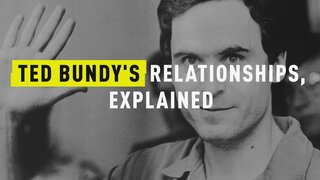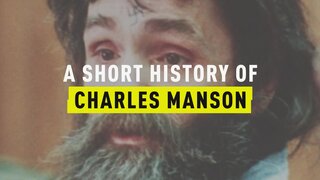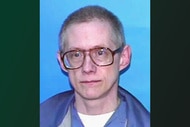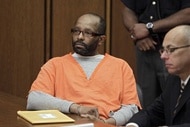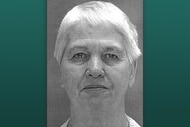Create a free profile to get unlimited access to exclusive videos, breaking news, sweepstakes, and more!
What Was The ‘Entity’ That Ted Bundy Claimed Drove Him To Torture And Murder Women?
Serial killer Ted Bundy often claimed that he was driven to rape and kill by an “entity” that lived in his head.
As one of the most violent serial killers in recent history, Ted Bundy is rightfully infamous: He commited a multitude of crimes that a judge would later describe as “extremely wicked, shockingly evil, and vile.”
He’s responsible for the violent deaths of more than 30 people, but were there other forces at play that drove him to commit his crimes? That seems to be what he believed, at least in part. Before his execution in 1989, Bundy often referred to an “entity” or “malignant being” as the driving force behind his kills — a literal voice in his head that compelled him to commit violent acts and whose will he could not deny. So what is the story behind this "entity?"
In Netflix’s new Bundy docu-series, “Conversations with A Killer: The Ted Bundy Tapes,” journalists Stephen G. Michaud and Hugh Aynesworth, whose death row interviews with Bundy are the meat of the series, recalled their many lengthy conversations with Bundy. They note he frequently referred to himself in the third person, even as he began to explain his own personal history, crimes, and the so-called mysterious force that drove him to kill.
In their book, ‘The Only Living Witness: The True Story of Serial Sex Killer Ted Bundy,” Michaud and Aynesworth theorized that Bundy spoke about his acts in the third person as an attempt to protect himself from legal repercussions. The individual that he constantly referred to was almost definitely himself.
Bundy claimed that porn was the root of the problem
Bundy’s violent desires were born out of an addiction with pornography, he once claimed, though he did so hypothetically, and while referring to himself as "this person."
“Now let’s consider the possibility that this person suffered from some sort of acute onset of a desire that resulted in killing young women,” Bundy can be heard saying in one interview featured in the Netflix special. “How do you account for it?”
“The early manifestations of this condition, which is an interest concerning sexual images, your standard fare that you’d see in a movie house or a Playboy magazine... the interest becomes skewed toward a more specialized literature, some of it pretty grotesque, which would preoccupy him more and more,” he said. “It would reach a point where the anger, the frustration, the anxiety, the poor self-image, feeling cheated, wronged, insecure — he decides upon young attractive women being his victims.”
Michaud recalled that Bundy said that the feeling in him “grew and grew” until the so-called entity “controlled him and he would hear a voice and he did as the entity told him to do.”
What the entity would tell him to do, it would later become clear, was torture, rape, and kill unsuspecting people, most of them young women, in disturbingly brutal ways.
What was the entity?
In “The Only Living Witness,” Michaud and Aynesworth recalled that Bundy referred to the presence of the entity in him as a “hybrid situation.” The entity was in him and of him, he explained. It was a “purely destructive power that grew from within,” they wrote. The entity — and Bundy, by extension — was gratified by “possessing” his victims absolutely.
On one notable occasion described during the Netflix special, Bundy — whose normally blue eyes turned black when the discussion grew intense, Michaud said — walked his interviewer through a hypothetical murder, explaining the role that the "entity" plays in its host’s desire to kill.
“One particular evening, he was driving down a fairly dark street and saw a girl walking along the street, and [he] parked his car and ran up behind the girl and she heard him,” he said. “She turned around and he brandished a knife, and grabbed her by the arm, and told her to do what he wanted her to do.”
“Let’s say he placed his hands around her throat, just to throttle her into unconsciousness so that she wouldn’t scream anymore,” he continued. “When the need of that malignant condition had been satisfied through sexual release, he realized that he couldn’t let the girl go. So killing, to a degree, will become a way of destroying evidence. But the act of killing becomes an end in itself.”
Bundy referenced the entity during a call with his girlfriend
Bundy not only addressed the “entity” to his interviewers, but he also discussed it with his then-girlfriend Elizabeth Kloepfer at least once.
Shortly after his arrest in Pensacola, Florida in 1978, Bundy struck a deal that would allow him to speak to Kloepfer on the phone. Though he avoided the topic of the sorority house murder rampage he’d committed earlier that year, he again referenced being controlled by an outside force, Kloepfer recalled in audio of an interview that was featured in the Netflix special.
“He told me that he was sick and that he was consumed by something that he didn’t understand and that, um, that it — that he just couldn’t contain it,” she said. “He spent so much time trying to maintain a normal life and he just couldn’t do it. He said that he was preoccupied with this force.”
Some would theorize that the “entity” that Bundy referenced was a sign of mental illness. While he was officially diagnosed with manic depression during one of his periods of incarceration, in “The Only Living Witness,” authors Michaud and Aynesworth wrote that Bundy cared greatly that they understood that “the killer” — he, himself — did not suffer from schizophrenia, dissociative personality disorder, or any other mental illness to which his actions and the voice in his head could be attributed.
“It is truly more sophisticated than that,” Bundy allegedly told them.
It’s not uncommon for killers to blame their vicious acts on unseen or unexplained outside forces. "The devil made me do it" defense is a classic among killers. David Berkowitz, more widely known as the New York-based serial killer “Son of Sam,” claimed that demonic forces possessed dogs and commanded him to murder. Herbert Mullin, a serial killer who killed thirteen people during the 1970s, also blamed voices in his head who supposedly told him that killing people would prevent earthquakes.
[Photo: Getty Images]

